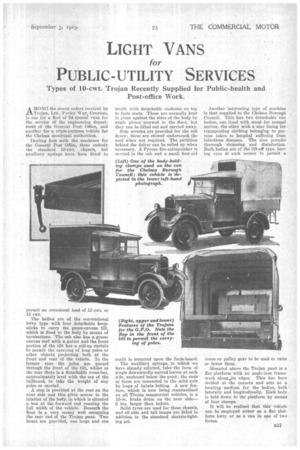• LIGHT VANS
Page 51

If you've noticed an error in this article please click here to report it so we can fix it.
for
PUI3LIC-UTILITY SERVICES
Types of 1111-cwt: Trojan Recently Supplied for Public-health and Post-office Work.
AMONG the recent orders received by Trojan, Ltd., Purley Way, Croydon, is one for a fleet of 54 special vans for the service of the engineering department of the General Post Office, and another for a triple-purpose vehicle for the Chelsea municipal authorities.
Dealing first with the machines for the General Post Office, these embody the standard 10-cwt. chassis, but auxiliary springs have been fitted to permit an occasional lead of 13 cwt. or 15 cwt.
The bodies are of the conventional lorry type with four detachable hoopsticks to carry the green-canvas tilt, which is fixed to the body by means of turnbuttons. The cab also has a greencanvas roof with a gutter and the front portion of the tilt has a roll-up curtain to permit the carrying of long poles or other objects projecting both at the front and rear of the vehicle. In the former case the poles are passed through the front of the tilt, whilst at the rear there is a detachable cross-bar, approximately level with the top of the tailboard, to take the weight of any poles so carried.
A step is provided at the rear on the near side and this gives access to the interior of the body, in which is situated a box at the forward end running the full width of the vehicle. Beneath the floor is a very roomy well occupying the rear end of the Trojan punt Two boxes are provided, one large and one small, with detachable cushions on top to form seats. These are normally kept in place against the sides of the body by angle pieces screwed to the floor, but they can be lifted out and carried away.
Side screens are provided for the cab doors ; these are stowed underneath the roof when not required. The partition behind the driver can be rolled up when necessary. A Pyrene fire extinguisher is carried in the cab and a small first-aid outfit is mounted upon the facia-board.
• The auxiliary springs, to which we have already referred, take the form of single downwardly curved leaves at each side, anchored below the punt ; the ends of these are connected. to the solid axle by loops of balata belting. A new feature, which is now being standardized on all Trojan commercial vehicles, is a 15-in. brake drum on the near side3 ins, larger than before.
Solid tyres are used for these chassis, and oil aide and tail lamps are fitied in addition to the standard electric-lighting set. Another interesting type of machine is' that supplied to the Chelsea Borough Council. This has two detachable van bodies, one lined with .wood for normal service, the other with a zinc lining for transporting clothing belonging to persons taken to hospital suffering froni infectious diseases. The zinc permits thorough cleansing _ and. disinfection. Both bodies are of the lift-off type, haying eyes at each corner to permit a crane or pulley gear to be used to raise or lower them.
Mounted above the Trojan punt is a flat platform with an angle-iron framework along .its edges. This has been welded at the corners and acts as a locating medium for the bodies, both laterally and longitudinally. Each body is held down to the platform by means of four clamps.
It will be realized that this vehicle can be employed either as a flat platform lorry or as a van in one of two forms.




















































































































